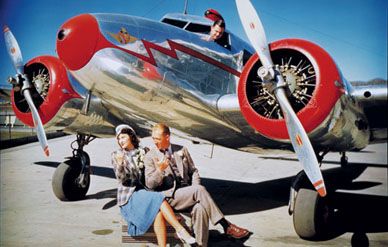Lockheed Electra 10A
The New England Air Museum discovers the power of Lockheed’s 10.
"I SAW AIRPLANES LIKE THIS ONE COMING AND GOING many times in my high school years,” says Bill Taylor, nodding at the Lockheed Electra in a hangar at the New England Air Museum, outside Hartford, Connecticut. Taylor’s boyhood home in St. Paul, Minnesota, was located on a cliff overlooking the Mississippi River and Holman Airport. Northwest Airlines sent its Electras in and out of the latter several times a day, flying passengers and freight to and from Chicago.
In 1934 this particular Electra, a 10A, serial no. 1052, rolled off the Lockheed assembly line in Burbank, California, just three serial numbers before the 10E, a model with more powerful engines, in which Amelia Earhart would disappear in the Pacific in 1937. The U.S. Navy was 1052’s first owner. Dressed in navy blue and bearing the Navy designations XR20-1 and BuNo 0267, the Electra was the personal transport of Secretary of the Navy Claude Swanson. During World War II, it transported Assistant Secretary of Naval Air David Ingalls. Post-war, the airplane went through nine owners, working for a drilling company and carrying freight and passengers. In 1979, North Carolina resident Dolph Overton bought it from Skyway Aviation in Missouri and set about restoring it for his Wings and Wheels Museum.
In 1983, along came Grace McGuire, who dreamed of reenacting Earhart’s flight. Searching for a 10E, she found a basket case at a Christie’s auction. United Technologies (parent company of Pratt & Whitney, which had made the Electra’s engines) heard of her plan and offered to restore the 10E to flying condition. Once the aircraft was evaluated, however, it was plain that the project would bust its budget. Plan B: Find one of the more plentiful 10As, replace the R-985 Wasp Jr. engines with the more powerful R-1340 Wasps that the 10E wore, and use McGuire’s 10E for parts. In 1984, United Technologies bought Dolph Overton’s 10A and got to work. Then McGuire fell ill with Lyme disease, and United Technologies changed management and ditched the McGuire project. The company returned McGuire’s 10E to her (last spring, it was up for sale) and gave the 10A to the New England Air Museum.
There was no space for it at the time, so the museum put it up in a Pratt & Whitney employee’s storage space in Lisbon, Connecticut, with the proviso that if it remained there longer than 10 years he could have it. In 1994, two days before the deadline, the museum hauled the fuselage out in the sling of an Army National Guard helicopter and flew it to its brand-new hangar.
The 84-year-old Taylor, a 20-year museum volunteer, has been working on the restoration ever since. He and a team tore it down and cleaned it, bolted on the wings and the tail assembly, repaired damaged cowls and nacelles, rebuilt the engines, reassembled the instrument panel and landing gear, fabricated missing wooden parts, and stripped, polished, and painted everything. Now, with just the interior left to complete, Taylor is the only one working on the airplane.
Taylor has refurbished the exterior in the livery of Northwest Airlines. “When we got it, the question was: Do we restore it to the way it came off the line?” says Taylor. “But the feeling was we had enough military airplanes.”
The museum’s Electra is not ergonomically friendly: You have to bend over at a 90-degree angle just to enter the rear cabin doorway. Taylor has 10 red leatherette seats positioned on both sides of the cabin and an aisle barely wide enough to walk in. In the original Electra the seats were probably cloth-covered, Taylor says, but he has no clue as to the colors or pattern. (He asks that anyone who might recall Northwest Electra interiors call him at (860) 623-3305 or e-mail him at [email protected].) There is a lavatory, he points out, behind a bulkhead door in the aft cabin, in a crawl space four feet square, with essentially a chamber pot tucked into one corner. “You had to think twice before you wanted to go to that bathroom,” he says.
Mysteries abound. There’s a vintage Electra radio microphone wrapped around a yoke, but no place to plug it in. “We’re trying to find where the radio equipment was installed, but none of the Electra pilots could recall it,” Taylor says. “I think it went under the copilot’s seat, but Grace said ‘No way.’ We have no instruction books that tell you how to put it back together. The external parts aren’t so bad—it’s obvious where the wings go.”
Everything else requires detective work.
